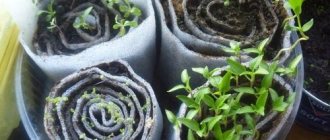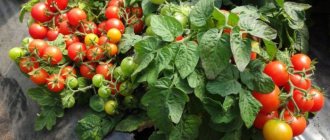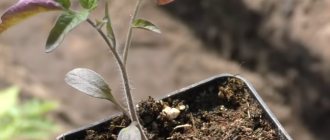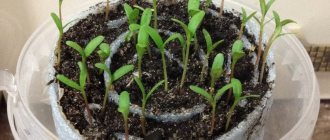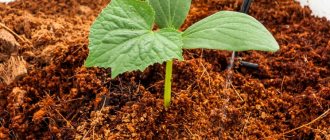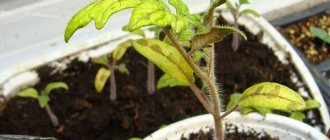Planting seedlings in diapers is the optimal solution in cases where there is clearly not enough space on the window for growing. In this case we are talking about the use of film for planting seeds. Let us immediately make a reservation that the method is unusual and was first tried by residents of Moscow. Which is not surprising, because in the capital, a square centimeter of free space is too expensive to clutter an apartment with containers of seedlings.
Planting seedlings in diapers
Today’s article will discuss how to sow and plant plants in film. First, let's look at the features of the method, its strengths and weaknesses.
About the features of diaper seedlings, advantages and disadvantages
If, while preparing for the coming summer season, you hear about seedlings in diapers, then do not think that we are talking about a children's cotton sheet, even though the principle of “wrapping” is similar for both cases. By plant wrap we mean PET film - for example, the one used to cover greenhouses and hotbeds. In some cases, instead of film, a simple transparent bag can be used, the dimensions of which on average are 20x30 centimeters. Such bags, by the way, are not recommended, as they can significantly deteriorate the quality of the grown seedlings.
Growing seedlings in diapers is a good way to save space on the windowsill
Be that as it may, the use of film allows you to avoid cluttering the window sills with numerous plastic cups, pots or seedling boxes.
Note! Due to the fact that it was the residents of Moscow who were the first to appreciate the method described in the article, one of its several options began to be called “Moscow style”. But that’s not what we’re talking about now.
As for the advantages of the method, these include:
- significant space savings when planting seeds;
- convenience of picking seedlings;
- reducing the required volume of nutrient soil mixture;
- the possibility of using it (the method) as a “plan B” in case nothing worked out with the main seedlings;
- protection of seedlings from diseases that are transmitted through the soil (for example, from blackleg);
- ease of checking the germination of seeds (especially last year’s).
Seedlings in diapers will save space on the windowsill
However, there are also disadvantages that should also be kept in mind; in particular, these include the following points:
- seedlings receive less light and therefore develop slowly;
- after the emergence of seedlings, picking may be required (much depends on the specific type of plant);
- Despite the intensive growth of the stems, the roots develop rather weakly.
Note! The use of diapers is applicable for most cold-resistant plants (not only flowers, but also vegetables). In the future, such plants will not require transplanting into separate containers before final rooting. As for heat-loving crops, they will have to be replanted in any case.
As mentioned earlier, there are several ways to “swaddle” seedlings. Some grow plants in film with soil or coconut substrate, while others do without them altogether. Also, only seeds can be packaged in film for the purpose of their subsequent transplantation into individual containers with soil. And so that you can choose the most suitable method for yourself, we will familiarize ourselves with all the existing options.
Seedlings in a diaper
By the way, regardless of the chosen method, you can always resort to a little trick. Take a strip of adhesive tape and write the number/name of the variety on it, then stick it on the diaper. You can also write directly on the film using a waterproof marker (here you need to wait until the writing dries). In this case, you will not only not get confused, but will also be able to observe the germination of different varieties.
Cups with seedlings are numbered
Method one. We use already sprouted seeds
First you must prepare everything you need:
- PET film;
- box;
- rubber bands for money;
- soil mixture;
- adhesive plaster;
- marker;
- scissors;
- actually, seeds (you can use tomatoes, cabbage, cucumbers, eggplants).
Seedlings in diapers with soil
Prices for PET film
pet film
Step 1. First of all, prepare and germinate the seeds (the specific method of germination does not play a special role here).
Germination of seeds
Step 2. Take the prepared film and cut out rectangles from it, the dimensions of which are close to the size of a sheet from a school notebook.
Step 3. Take one such rectangle and place a tablespoon of moistened soil mixture in its upper left corner.
Planting a sprout in polyethylene
Step 4. Place the sprout on top of the soil mixture, but so that the leaves are located above the film.
Landing in diapers
Step 5. Now once again place about one tablespoon of wet soil mixture.
Step 6. You can start “swaddling” the seedling. To do this, you must bend the bottom edge of the rectangle, and then form a roll from the film. Twist the roll loosely, otherwise oxygen will not flow inside.
Swaddling example
Step 7. All that remains is to fix the film so that it does not unfold. Use prepared rubber bands for money for this.
Note! You can place the “wrapped” seedlings closely in a pre-prepared box. Place the box itself on the windowsill, choosing a well-lit place for this. Using adhesive tape, make stickers for the seedlings.
Finished rolls in a box
You can also cover the box with cling film with ventilation holes pre-pierced in it. Alternatively, you can simply open the film every day for about 20 minutes.
Cassettes for seedlings
A seedling cassette is a block consisting of separate containers of different volumes (from 20 to 500 ml). The number of cells in a cassette can be different - from 4 to 390. A separate sprout is planted in each cell. Read more here.
Technology for planting tomatoes in diapers
To plant tomatoes in diapers, you will need a small amount of soil. Gardeners using this method say that 50 sprouts require about 2 kg of soil mixture. The amount of film is also easy to calculate. For one seedling you will need a piece measuring 20 x 30 cm . It is not necessary to buy new film; scraps of used covering material from a greenhouse are quite suitable for this purpose. But first, the film must be washed with a solution of laundry soap and treated with copper sulfate in the proportion of 100 g of powder per 10 liters of water to destroy pathogenic microbes that can infect seedlings. To secure the rolls, prepare tape.
Instead of garden film, you can use plastic packaging bags, but they are less convenient and, according to gardeners, the seedlings in them turn out to be more frail.
Methods of landing in diapers
Diapers are used for sowing sprouted seeds, transplanting seedlings and picking grown seedlings. Planting methods may vary.
Method two. We grow “Moscow style”
This method does not require preliminary germination of seeds. But space will be saved significantly - for example, about 100 seedlings can sprout on one windowsill.
Growing seedlings “Moscow style”
Before you begin, you must prepare:
- seeds;
- marker;
- plastic film;
- scissors;
- toilet paper;
- patch;
- small containers (disposable plastic cups are an excellent option);
- rubber bands for money;
- spray.
After preparing everything you need, you can proceed directly to the work process. For the convenience of visitors, the instructions are given in the form of a small table.
Table. The “Moscow” method of growing seedlings - a step-by-step guide.
| Steps, illustrations | Description of actions |
| Step 1 | Cut the PET film into long strips, each 10 centimeters wide. To make cutting easier, you can lay the film on top of white toilet paper. The length of each strip should be about half a meter (it all depends on the number of seeds). Place one layer of the same paper on top of the finished strips. |
| Step 2 | Lightly dampen the toilet paper. If you have a spray bottle, you can spray the paper with it. |
| Step 3 | Place the seeds in 5cm increments approximately 1.5cm from the edge. Use tweezers for this, as in the image. |
| Step 4 | Cover it all with a similar strip of PET film. |
| Step 5 | Next, roll the resulting multilayer strip into a kind of roll. At the same time, try to minimize the displacement of the film layers. |
| Step 6 | Secure the roll with a rubber band. If required, sign it. |
| Step 7 | Place the roll in a plastic cup, then pour a 4-centimeter layer of water into it. |
| Step 8 | Place the glass in a bag, puncturing small ventilation holes in the bag. After germination, apply min. fertilizer (the concentration of the nutrient solution should be half that for standard fertilizing). The best option is humic seedling fertilizers. Maintain the original water level in the glass. After the first true leaf appears, apply a second feeding. |
| Step 9 | Grown seedlings need picking. For onions, for example, this is the period when developed roots appear, and for leafy vegetables, this is the time of the first true leaf. First, roll out the roll, then remove the top strip of film. |
| Step 10 | Divide the seedlings directly with the paper; when cutting, try not to damage the fragile roots. If some seeds did not have time to sprout, leave them for further growing, that is, put them back in the glass, after rolling them into rolls. |
| Step 11 | Plant the plants in cassettes or pots along with toilet paper. If we are talking, for example, about onions, then they can be planted directly in the ground due to their cold resistance. Therefore, sowing dates must be calculated with maximum accuracy (somewhere around mid-April, but the timing may vary depending on the time of planting in a particular region). |
| Step 12 | Water the planted seedlings with a small amount of water. |
Note! Further care in this case is not much different from growing ordinary seedlings. Therefore, we move on to the next method of “swaddling”.
Care
Every day the cellophane is removed from the crops for ventilation. Remove condensation. It’s even better to have 2 pieces of film for each container. One is removed to dry, the other is covered with tomatoes.
Water into a tray. The water should not rise too high to prevent the soil from soaking or the toilet paper to absorb too much moisture.
When the tomato seeds hatch, they are transferred for 7 days to a cool, bright room with a temperature of 14-16 ° C. The seedlings will already stretch out, but if this rule is neglected, they will turn into frail thin threads.
After a week, containers with diapers should be kept in a room with a temperature of about 20° C. Tomatoes will need lighting even on a sunny windowsill - the seedlings grow too crowded. The lamp should be placed not on the side, but above the seedlings.
For tomato seeds planted in the substrate, the nutrients contained in it will be sufficient for the first time. Diapers with toilet paper are fed weekly with a weak solution of humic fertilizers, added to the water.
It is imperative to monitor the liquid accumulated at the bottom of common containers. Ideally, drain it before each watering.
Method three. We use the substrate
This method is very similar to the previous one, however (due to the use of a small amount of soil when sowing) the film will be preserved until the seedlings take root in the garden bed. This stage can be skipped if the seedlings are subsequently planted under some kind of shelter and early. Similarly, seedlings are planted in diapers after diving.
The algorithm of actions will look something like this.
Step 1. First, prepare a moistened soil mixture, as well as film strips, as in the previous method. The film can be covered with toilet paper, although in this case it is not necessary.
The film is covered with damp toilet paper
Step 2. Plant seeds (any seeds, including germinated ones) or sprouts. The distance should be several centimeters.
Seeds are laid out on damp toilet paper
Step 3. Sprinkle some moistened soil on top, then cover with paper and film.
Step 4. Roll it all up, secure it with an elastic band, and place it in a tray.
Ready roll
Common Mistakes
When planting tomato seeds in a snail, gardeners often make a number of mistakes.
- Why do tomato seedlings fall? To ensure that the seedlings turn out to be of high quality, you should not delay removing the film. If this is not done immediately after the sprouts appear, they will stretch out, which will lead to the seedlings falling. This is due to the presence of a lingering greenhouse effect.
- To prevent the seeds from sliding down, you need to roll the roll tightly.
- The quality of the seedlings is affected by untimely picking, which is done after the roots appear at the bottom of the snail.
There are different ways to grow tomatoes. We suggest you read how to do this in twists, on two roots, in bags, in peat pots, in buckets upside down, upside down, in pots, the Chinese way and in a barrel.
The method of growing tomato seedlings using the snail method is becoming more popular every year. The process of sowing seeds into snails is quite simple and very effective. It also stands out for its ease of transportation. For example, they are easier to transport to the country than pallets with pots or bunches of tomato seedlings.
Key features of growing vegetable seedlings
If you intend to grow cucumber seedlings, then the seeds should be soaked before “swaddling,” since their skin is too thick for paper, which is moistened by capillaries with water. The container can be made of glass or plastic; you must first place cotton wool or a piece of natural fabric on the bottom. It is also advisable to place material (pre-moistened) on top of the seeds, and then leave everything for 48 hours.
Soaking cucumber seeds
As for the hybrid tomatoes obtained from diaper seedlings, they branch strongly, so you can forget about even bushes. Therefore, it is advisable to plant only tomato varieties in film that retain their own varietal characteristics from generation to generation. In terms of yield, this will not give any result, but the plants will not look crooked and unkempt.
Tomatoes in diapers
The roots of tomato seedlings sown in diapers will not grow in depth, but in breadth (due to cramped conditions). In this case, there is no need to water bushes transplanted into the ground, since the root system will be able to get moisture everywhere.
Tomato seedlings in diapers
But with peppers everything is more serious - they do not grow long roots, and even the peripheral ones in the film will not be able to develop normally, so they need to be watered throughout the entire season.
Peppers in diapers
Note! While still in diapers, you can grow greens all year round (for sale or for your own needs). Soil is practically not needed, only fertilizer is required. At the same time, greenery will take up almost no space.
The essence of the method
Sowing tomatoes in snails is considered an effective way . With its use, there is no need to tinker with boxes or frequently water seeds and seedlings.
The essence of this original method is to save space and obtain strong seedlings.
Main nuances
Snail casting is an unusual method of laying soil and seeds for planting . How to plant tomato seeds with soil? In this case, the earth is initially poured onto a long strip made of various materials. This base, together with the soil, is carefully twisted, resulting in something like a stuffed roll.
Advantages and disadvantages
The advantages, in addition to saving space, are:
- good germination;
- free development of the root system;
- convenience when picking;
- the ability to regulate lighting as a result of turning the cochlea.
Watering seeds becomes easier. Water is poured into the container in which the snail stands, thereby keeping the soil constantly moist. You don't need a lot of soil for sowing . Even with the same care, seedlings grow differently. The snail, depending on strength and height, allows you to adjust the landing and picking.
The disadvantages of this method are that when there is a lack of lighting, the sprouts stretch out. In this case, additional lighting will be needed.
How to care for diaper seedlings, diving
Care in our case is not complicated and consists of the following points:
- timely removal of condensate;
- regular feeding (twice a week) with humic acids and half the concentration of the solution than usual;
- additional lighting (if there is not enough sunlight);
- regular but not frequent watering.
If we talk about picking seedlings from diapers, this is also a fairly simple procedure. Take the roll, unfold it and determine exactly where the roots are.
Unrolled roll with seedlings
Next, step back a few centimeters from this level, and then pin the root. Next, remove the second layer of PET film and transplant the sprout into a separate container along with the paper (the latter will quickly decompose in the future).
Picking seedlings into the ground
Video - Diving tomatoes into diapers
Seed preparation
Before planting, the seed material is sorted, rejecting damaged and stuck together specimens. To reject empty seeds, soak them in salted water for 3 hours. All the seeds that float to the top are thrown away; they are empty and will not sprout.
Then, to improve germination, the seeds are soaked for 12 hours in a nutrient solution. To do this, use growth stimulants, diluting them according to instructions in lukewarm water.
Important! You can do without soaking when sowing. In this case, nutrients are added to the soil or water for irrigation.
If tomatoes will be grown in cold climates, it is recommended to harden them off before sowing. To do this, the seeds are soaked in the evening, and in the morning they are taken out into the cold for 4 hours or placed in the refrigerator for the same time. Then the procedure is repeated again.
How to plant diaper seedlings in open soil?
Despite the ease of growing, seedlings in film are much worse off than in separate pots. Therefore, they need to be transplanted into the ground as soon as possible. You are lucky if there is a greenhouse on the site - in this case, the transplant can be done early, without the risk of freezing the seedlings. But in the absence of a greenhouse, things will be somewhat different.
Seedlings in a film diaper
If diaper seedlings are planted early in open soil, the plants will need protection from the cold, so make a “cushion” under the bed using paper, feathers (you will have to gut the old cushions), straw or sawdust. This way the seedlings will be heated from below. From above, if there is a threat of frost, cover the plants with film or use plastic bottles for this purpose. You can use burdock to cover young cucumbers.
Planting seedlings in open ground
As a result, we note that all the diaper methods of growing seedlings described above require a minimum of time, soil and space, and therefore are ideal for people who do not want to spend a lot of money or work. Of course, the plants turn out to be weaker, but with proper care they will produce the same high-quality harvest as in the case of growing seedlings in the usual way.
Step-by-step instruction
To sow tomato seeds in a snail you need to have:
- the snail itself;
- prepared seeds;
- priming;
- spray bottle with water.
Sowing seeds
- First of all, the tape is placed on the table so that one end is in the person’s hands.
- A layer of soil is poured over its entire surface, which should preferably be moistened in a growth regulator.
- Using tweezers, place the seeds at a distance of 2.5 cm from each other, and 1 cm from the edge and top of the tape.
- They are sprinkled on top with a thin layer of soil, which is moistened with water from a spray bottle. The soil needs to be moist, not wet.
- After this, the tape is carefully twisted, secured with an elastic band.
The resulting snail must be placed in a container. It must be placed so that the edge to which the seeds are located closest is on top. If the ground is lower than the tape, it is filled up. A transparent bag is put on top.
We invite you to watch a video about sowing seeds in a snail:

